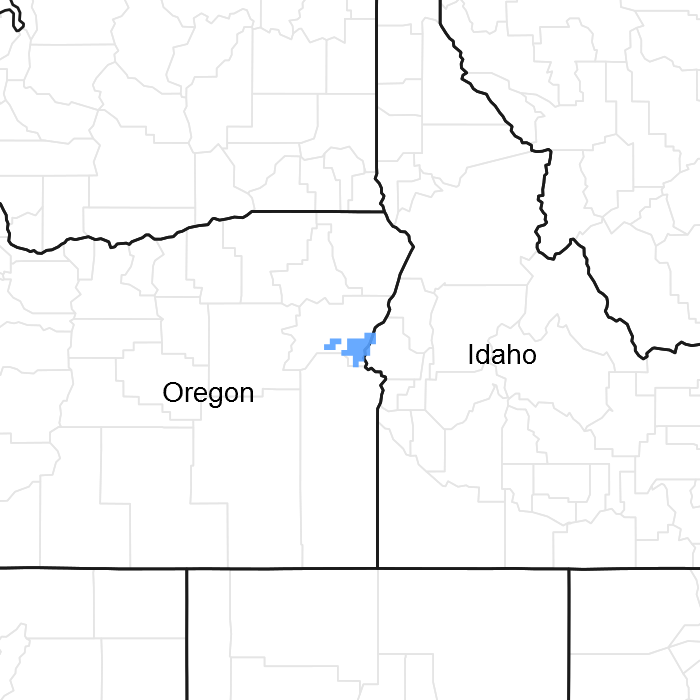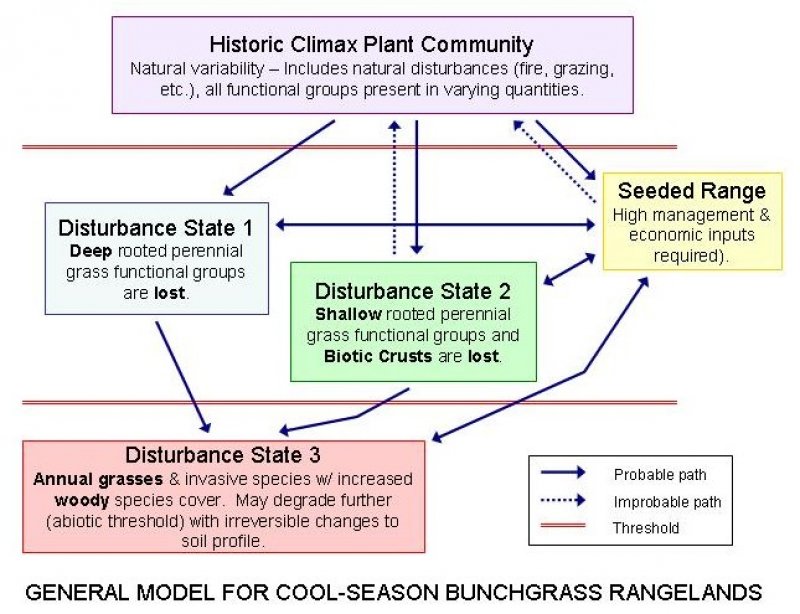
Natural Resources
Conservation Service
Ecological site R010XC052OR
SR Shallow South Schist 9-12 PZ
Last updated: 5/13/2025
Accessed: 12/07/2025
General information
Provisional. A provisional ecological site description has undergone quality control and quality assurance review. It contains a working state and transition model and enough information to identify the ecological site.

Figure 1. Mapped extent
Areas shown in blue indicate the maximum mapped extent of this ecological site. Other ecological sites likely occur within the highlighted areas. It is also possible for this ecological site to occur outside of highlighted areas if detailed soil survey has not been completed or recently updated.
Associated sites
| R010XC044OR |
SR South Schist 9-12 PZ South Schist 9-12" PZ |
|---|
Similar sites
| R010XC044OR |
SR South Schist 9-12 PZ South Schist 9-12" PZ (deeper soil, higher production) |
|---|
Table 1. Dominant plant species
| Tree |
Not specified |
|---|---|
| Shrub |
(1) Glossopetalon spinescens |
| Herbaceous |
(1) Pseudoroegneria spicata ssp. spicata |
Physiographic features
This site occurs on rocky canyon walls and south facing sideslopes of hills and ravines.
Table 2. Representative physiographic features
| Landforms |
(1)
Hill
(2) Ravine (3) Canyon |
|---|---|
| Elevation | 610 – 1,219 m |
| Slope | 30 – 80% |
| Aspect | S |
Climatic features
The annual precipitation ranges from 9 to 12 inches, most of which occurs in the form of snow during the months of November through March. Localized, occasionally sever, convectional storms occur during the summer. The soil temperature regime is mesic with a mean annual air temperature of 50 degrees F. Temperature extremes range from 100 to -20 degrees F. The frost free period ranges from 110 to 140 days. The optimum period for plant growth is from April through May.
Table 3. Representative climatic features
| Frost-free period (average) | 140 days |
|---|---|
| Freeze-free period (average) | |
| Precipitation total (average) | 305 mm |
Influencing water features
Soil features
The soils of this site are typically shallow and well drained with areas of rock outcrop. Typically the surface layer is a channery loam about 3 inches thick. The subsoil is a very channery loam to about 16 inches. Depth to bedrock is 10 to 20 inches. Permeability os moderate. The available water holding capacity is about 2 to 4 inches for the profile. The potential for erosion is severe.
Table 4. Representative soil features
| Surface texture |
(1) Loam |
|---|---|
| Family particle size |
(1) Loamy |
| Drainage class | Well drained |
| Permeability class | Moderate |
| Soil depth | 25 – 51 cm |
| Available water capacity (0-101.6cm) |
5.08 – 10.16 cm |
Ecological dynamics
This site is most susceptible to erosion by water. Where this has occurred, the underlying parent material may be exposed. If the condition of the site deteriorates as a result of overgrazing, bluebunch wheatgrass decreases while cheatgrass and other annuals increase. Bare soil increases rapidly and erosion is accelerated.
State and transition model

More interactive model formats are also available.
View Interactive Models
More interactive model formats are also available.
View Interactive Models
Click on state and transition labels to scroll to the respective text
Ecosystem states
State 1 submodel, plant communities
State 1
Historic Climax Plant Community
Community 1.1
Historic Climax Plant Community
The potential native plant community is dominated by Snake River greasebush and bluebunch wheatgrass. Spiny hopsage is common in the stand. Vegetative composition of the community is approximately 75% grasses, 10% forbs, and 15% shrubs.
Figure 2. Annual production by plant type (representative values) or group (midpoint values)
Table 5. Annual production by plant type
| Plant type | Low (kg/hectare) |
Representative value (kg/hectare) |
High (kg/hectare) |
|---|---|---|---|
| Grass/Grasslike | 359 | 401 | 443 |
| Shrub/Vine | 45 | 82 | 163 |
| Forb | 39 | 59 | 78 |
| Total | 443 | 542 | 684 |
Additional community tables
Table 6. Community 1.1 plant community composition
| Group | Common name | Symbol | Scientific name | Annual production (kg/hectare) | Foliar cover (%) | |
|---|---|---|---|---|---|---|
|
Grass/Grasslike
|
||||||
| 1 | Dominant, deep-rooted, perennial grasses | 336–392 | ||||
| bluebunch wheatgrass | PSSP6 | Pseudoroegneria spicata | 336–392 | – | ||
| 2 | Sub-dominant, deep-rooted, perennial grasses | 11–22 | ||||
| Thurber's needlegrass | ACTH7 | Achnatherum thurberianum | 6–11 | – | ||
| squirreltail | ELEL5 | Elymus elymoides | 6–11 | – | ||
| 4 | Sub-dominant, shallow-rooted, perennial grasses | 11–28 | ||||
| Sandberg bluegrass | POSE | Poa secunda | 11–28 | – | ||
|
Forb
|
||||||
| 7 | All dominant, perennial forbs | 11–17 | ||||
| buckwheat | ERIOG | Eriogonum | 11–17 | – | ||
| 8 | All sub-dominat, perennial forbs | 17–34 | ||||
| milkvetch | ASTRA | Astragalus | 6–11 | – | ||
| desertparsley | LOMAT | Lomatium | 6–11 | – | ||
| cliff beardtongue | PERU | Penstemon rupicola | 6–11 | – | ||
| milkvetch | ASTRA | Astragalus | 6–11 | – | ||
| desertparsley | LOMAT | Lomatium | 6–11 | – | ||
| cliff beardtongue | PERU | Penstemon rupicola | 6–11 | – | ||
| 9 | All other perennial forbs | 11–28 | ||||
| common yarrow | ACMI2 | Achillea millefolium | 1–3 | – | ||
| agoseris | AGOSE | Agoseris | 1–3 | – | ||
| onion | ALLIU | Allium | 1–3 | – | ||
| arrowleaf balsamroot | BASA3 | Balsamorhiza sagittata | 1–3 | – | ||
| larkspur | DELPH | Delphinium | 1–3 | – | ||
| western stoneseed | LIRU4 | Lithospermum ruderale | 1–3 | – | ||
| woodland-star | LITHO2 | Lithophragma | 1–3 | – | ||
| blazingstar | MENTZ | Mentzelia | 1–3 | – | ||
| phacelia | PHACE | Phacelia | 1–3 | – | ||
| goldenweed | PYRRO | Pyrrocoma | 1–3 | – | ||
|
Shrub/Vine
|
||||||
| 11 | Dominant, perennial, evergreen shrubs | 28–84 | ||||
| spiny greasebush | GLSP | Glossopetalon spinescens | 28–84 | – | ||
| 12 | Sub-dominant, perennial, evergreen shrubs | 11–22 | ||||
| rubber rabbitbrush | ERNA10 | Ericameria nauseosa | 6–11 | – | ||
| spiny hopsage | GRSP | Grayia spinosa | 6–11 | – | ||
| 14 | Sub-dominant, deciduous, perennial shrubs | 6–11 | ||||
| horsebrush | TETRA3 | Tetradymia | 6–11 | – | ||
Interpretations
Animal community
This site is critical for mule deer and elk.
Mule deer
Elk
Hawks
Rodents
Songbirds
Hydrological functions
The soils are in hydrologic group D. The soils of this site have high runoff potential.
Other products
This site is not suited to use by cattle, sheep or horses for grazing. The slopes are steep to very steep with unstable soils.
Other information
This site is not conducive to mechanical improvements due to steepness of slope, coarse and unstable soil conditions and limited cover.
Supporting information
Contributors
A. Bahn, H. Barrett
E Ersch
Rangeland health reference sheet
Interpreting Indicators of Rangeland Health is a qualitative assessment protocol used to determine ecosystem condition based on benchmark characteristics described in the Reference Sheet. A suite of 17 (or more) indicators are typically considered in an assessment. The ecological site(s) representative of an assessment location must be known prior to applying the protocol and must be verified based on soils and climate. Current plant community cannot be used to identify the ecological site.
| Author(s)/participant(s) | Jeff Repp |
|---|---|
| Contact for lead author | Oregon NRCS State Rangeland Management Specialist |
| Date | 08/07/2012 |
| Approved by | Kirt Walstad |
| Approval date | |
| Composition (Indicators 10 and 12) based on | Annual Production |
Indicators
-
Number and extent of rills:
None to some, severe shet & rill erosion hazard -
Presence of water flow patterns:
None to some -
Number and height of erosional pedestals or terracettes:
None -
Bare ground from Ecological Site Description or other studies (rock, litter, lichen, moss, plant canopy are not bare ground):
15-30% -
Number of gullies and erosion associated with gullies:
None -
Extent of wind scoured, blowouts and/or depositional areas:
None, moderate wind erosion hazard -
Amount of litter movement (describe size and distance expected to travel):
Fine - limited movement -
Soil surface (top few mm) resistance to erosion (stability values are averages - most sites will show a range of values):
Moderately resistant to erosion: aggregate stability = 3-5 -
Soil surface structure and SOM content (include type of structure and A-horizon color and thickness):
Shallow well drained channery loam (3 inches thick): Low OM (0-2%) -
Effect of community phase composition (relative proportion of different functional groups) and spatial distribution on infiltration and runoff:
Low ground cover (20-40%) and moderate to steep slopes (30-80%) slightly limit rainfall impact and overland flow -
Presence and thickness of compaction layer (usually none; describe soil profile features which may be mistaken for compaction on this site):
None -
Functional/Structural Groups (list in order of descending dominance by above-ground annual-production or live foliar cover using symbols: >>, >, = to indicate much greater than, greater than, and equal to):
Dominant:
Bluebunch wheatgrass > Snake River Greasebush > forbs > other shrubsSub-dominant:
Other:
Additional:
-
Amount of plant mortality and decadence (include which functional groups are expected to show mortality or decadence):
Normal decadence and mortality expected -
Average percent litter cover (%) and depth ( in):
-
Expected annual annual-production (this is TOTAL above-ground annual-production, not just forage annual-production):
Favorable: 800, Normal: 500, Unfavorable: 300 lbs/acre/year at high RSI (HCPC) -
Potential invasive (including noxious) species (native and non-native). List species which BOTH characterize degraded states and have the potential to become a dominant or co-dominant species on the ecological site if their future establishment and growth is not actively controlled by management interventions. Species that become dominant for only one to several years (e.g., short-term response to drought or wildfire) are not invasive plants. Note that unlike other indicators, we are describing what is NOT expected in the reference state for the ecological site:
Perennial brush species will increase with deterioration of plant community. Western Juniper readily invades the site. Cheatgrass and Medusahead invade sites that have lost deep rooted perennial grass functional groups. -
Perennial plant reproductive capability:
All species should be capable to reproduce annually
Print Options
Sections
Font
Other
The Ecosystem Dynamics Interpretive Tool is an information system framework developed by the USDA-ARS Jornada Experimental Range, USDA Natural Resources Conservation Service, and New Mexico State University.
Click on box and path labels to scroll to the respective text.